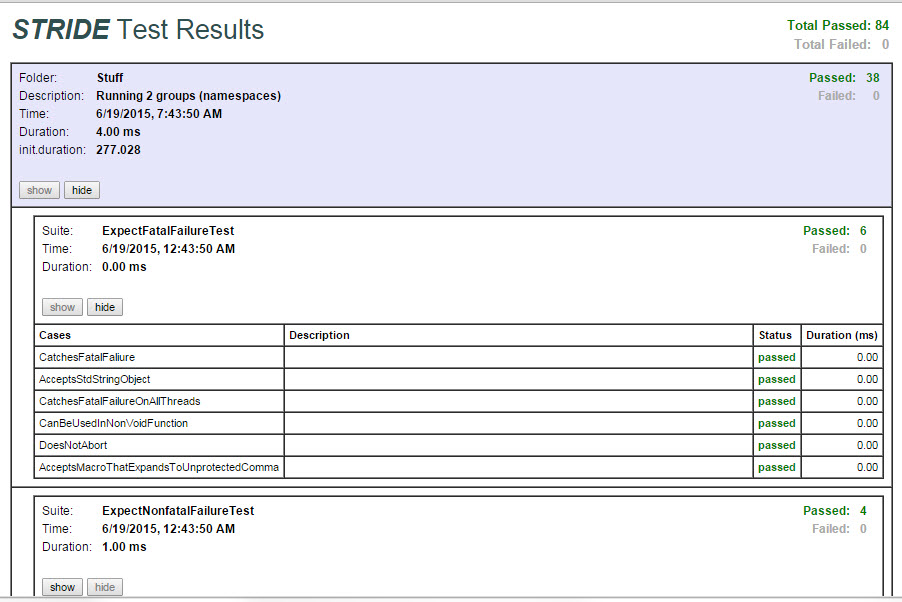Running Tests: Difference between revisions
Jump to navigation
Jump to search
No edit summary |
No edit summary |
||
| Line 30: | Line 30: | ||
== Input == | == Input == | ||
In order to run tests, you must provide the following information to stride.exe: | |||
;database file | |||
: This is the .sidb file that is created by the [[Build Tools]] during the target build process. This file contains meta-information used to run tests. | |||
;device parameters | |||
: This tells stride.exe how to connect to the target. | |||
;tests to run | |||
: A set of [[Test Modules Overview|script tests]] or [[Test Units|native target-based tests]] (Test Units) compiled in the database. You may also optionally specify named hierarchical suites in which to put the results of the tests you designate. | |||
== Output == | == Output == | ||
Upon test completion, test output is always written as follows: | |||
;console output | |||
: A quick summary of results is written to standard output. Test counts are shown for the categories of '''passed''', '''failed''', '''in progress''', and '''not in use''' | |||
;local xml file | |||
: Detailed results are written to a local xml file. By default, this file is written to the directory where the input STRIDE database file is located and given the same name as the database file with an extension of ".xml". If you open this file in a web browser, an xsl transform is automatically downloaded and applied before rendering. | |||
Optionally, you may also publish the results to [http://www.testspace.com Test Space] upon test completion. | |||
== Reference == | == Reference == | ||
Reference to the [[STRIDE_Runner| Stride Runner]] article. | |||
Revision as of 21:00, 1 July 2015
Stride executes tests using a runner controlled by a host computer that is physically connected to the target via a configurable communication channel (TCP/IP or serial port). The application software is required to be running, including the Stride runtime, to connect to the Stride Runner.
Block diagram
Invoking the Runner (aka stride) from a console
stride --database="%STRIDE_DIR%\SDK\Windows\out\TestApp.sidb" --device=TCP:localhost:8000 --run="*"
or for Linux/FreeBSD
stride --database="$STRIDE_DIR%/SDK/Posix/out/TestApp.sidb" --device=TCP:localhost:8000 --run="*"
Option files can be helpful (i.e. my.opt)
--database "%STRIDE_DIR%\SDK\Windows\out\TestApp.sidb" --device TCP:localhost:8000
stride --options_file my.opt --run "*"
Reviewing your Results
Input
In order to run tests, you must provide the following information to stride.exe:
- database file
- This is the .sidb file that is created by the Build Tools during the target build process. This file contains meta-information used to run tests.
- device parameters
- This tells stride.exe how to connect to the target.
- tests to run
- A set of script tests or native target-based tests (Test Units) compiled in the database. You may also optionally specify named hierarchical suites in which to put the results of the tests you designate.
Output
Upon test completion, test output is always written as follows:
- console output
- A quick summary of results is written to standard output. Test counts are shown for the categories of passed, failed, in progress, and not in use
- local xml file
- Detailed results are written to a local xml file. By default, this file is written to the directory where the input STRIDE database file is located and given the same name as the database file with an extension of ".xml". If you open this file in a web browser, an xsl transform is automatically downloaded and applied before rendering.
Optionally, you may also publish the results to Test Space upon test completion.
Reference
Reference to the Stride Runner article.

